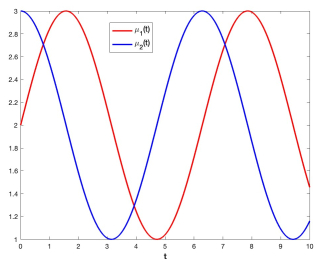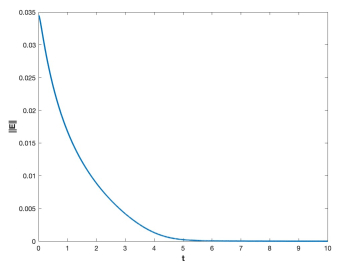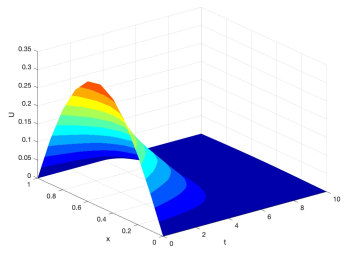1.
Introduction
As is wellknown the first non-trivial examples of minimal surfaces in 3-dimensional Euclidean space E3 are the catenoids, the helicoids and the minimal translation surfaces. A surface is called a translation surface if it is given by an immersion
where z=f(x)+g(y). Scherk proved in 1835 that the only minimal translation surfaces (besides the planes) are the surfaces given by
where a is a non-zero constant [1].
In [2], it has been shown that the minimal translation surfaces are generalized to minimal translation hypersurfaces as follows:
"Let Mn(n≥2) be a translation hypersurface in En+1 i.e. Mn is the graph of a function
where fi is a smooth function of one real variable for i=1,…,n. Then Mn is minimal if and only if either Mn is a hyperplane or a product submanifold Mn=M2×En−2, where M2 is a minimal translation surface of Scherk in E3."
In [3], Woestyne parameterized minimal translation surfaces in the 3-dimensional Minkowski space R31 with metric g=dx21+dx22−dx23, in the following theorems:
Theorem 1. Every minimal, spacelike surface of translation in R31, is congruent to a part of one of the following surfaces:
1. A spacelike plane,
2. The surface of Scherk of the first kind, a parametrization of the surface is F(x,y)=(x,y,a−1log(cosh(ay)/cosh(ax))), with tanh2(ax)+tanh2(ay)<1 [3].
Theorem 2. Every minimal, timelike surface of translation in R31, is congruent to a part of one of the following surfaces:
1. A timelike plane,
2. The surface of Scherk of the first kind, a parametrization of the surface is F(x,y)=(x,y,a−1log(cosh(ay)/cosh(−ax)))with tanh2(−ax)+tanh2(ay)>1.
3. The surface of Scherk of the second kind, a parametrization of the surface is F(x,y)=(x,y,a−1log(cosh(ay)/sinh(−ax))).
4. The surface of Scherk of the third kind, a parametrization of the surface is F(x,y)=(x,y,a−1log(sinh(ay)/sinh(−ax))).
5. A flat B-scroll over a null curve, a parametrization of the surface is F(x,y)=(x,y,±x+g(y))with g(y) an arbitrary function [3].
Seo, gave a classification of the translation hypersurfaces with constant mean curvature or constant Gauss–Kronecker curvature in Euclidean space or Lorentz– Minkowski space in [4]. Also they characterized the minimal translation hypersurfaces in the upper half-space model of hyperbolic space. In particular, they proved the following theorem:
Theorem 3. Let M be a translation hypersurface with constant mean curvature H in Rn+1. Then M is congruent to a cylinder Σ×Rn−2, where Σ is a constant mean curvature surface in R3. In particular, if H=0, then M is either a hyperplane or M=Σ×Rn−2, where Σ is a Scherk's minimal translation surface in R3[4].
And they can obtained a similar result in the Lorentz–Minkowski space as follows:
Theorem 4. Let M be a spacelike translation hypersurface with constant mean curvature H in Ln+1. Then M is congruent to a cylinder Σ×Rn−2, where Σ is a constant mean curvature surface in L3. In particular, if H=0, then M is either a hyperplane or M=Σ×Rn−2, where Σ is a Scherk's maximal spacelike translation surface in L3 [4].
In [5], Hasanis and Lopez classified and described the construction of all minimal translation surfaces in R3. In 2019, Aydın and Ogrenmis investigated translation hypersurfaces generated by translating planar curves and classified these translation hypersurfaces with constant Gauss-Kronecker and mean curvature [6]. Recently, many authors have studied the geometry of minimal translational hypersurface [7,8,9,10,11,12].
In [12], Yang, Zhang and Fu gave a characterization of a class of minimal translation graphs which are generalization of minimal translation hypersurfaces in Euclidean space. In this paper we study a characterization of minimal translation graphs in semi-Euclidean space.
2.
Characterization of minimal translation graphs in semi-Euclidean space
By the (n+1)-dimensional semi-Euclidean space with index ν, denoted by Rn+1ν, mean Rn+1 equipped with the semi-Euclidean metric
for which εi,(i=1,2,…,n+1) is either −1 or 1. We assume n≥2. The number of minus signs is equal to the index ν and is given by
Let Mn be a hypersurface of Rn+1ν for which the induced metric is non-degenerate. Then Mn can locally always be seen as the graph of a function F:Rn→R. In what follows, we will assume that f is a function of the coordinates x1,…,xn. This can easily be achieved possibly by rearranging the coordinates of Rn+1ν. So Mn is locally given by
Assume that Mn is minimal. This means that the mean curvature vector vanishes at every point. The graph Mn in the semi-Euclidean space Rnν is minimal if and only if
One easily calculates that minimality condition above [13].
A hypersurface Mn in the semi-Euclidean space Rn+1ν is called translation graph if it is the graph of the function given by
where u=n∑i=1cixi, ci are constants, cn≠0 and each fi is a smooth function of one real variable for i=1,2,…,n. Additionally in this paper, we assume that the following condition are provided:
fi vanishes nowhere for i=1,2,…,n, otherwise Mn is a non-degenerate hyperplane.
The minimality condition (2.3) can be rewritten as
Then we calculate the partial derivatives in the Eq (2.5) for the translation graph,
for 1≤i≤n−1. Since Mn is minimal, we substitute (2.6)–(2.8) into (2.5) and we obtain
Since cn≠0, we take the derivative of the Eq (2.9) with respect to xn, we have
According to the Eq (2.10), we get following cases:
Case 1. f′′′n=0.
With proper translation, fn=mu2 for a constant m≠0 such that fn=mu2. If m=0, then Mn would not be a translation graph. According to this, we rewrite (2.10)
Since m≠0, we get
In the first equation of (2.12), each f′′i depends on a different variable, then f′′i has to be a constant for i=1,…,n−1. Also, let be fi(xi)=aix2i, where ai is constant. Then from (2.12) we obtain following equations
Now we substitute fn=mu2 and fi(xi)=aix2i for i=1,…,n−1 in the Eq (2.9), we find
According to (2.13) and (2.14), we obtain
Since the above equation is a quadratic polynomial with x1,…,xn−1, by the arbitrariness of xi, we get
and
According to (2.16) and (2.17), we find
From (2.18), we can see that at most one akck≠0. Without loss of generality, we assume ak0ck0≠0 and every akck=0 for k≠k0. From (2.19), we get ak0≠0 and ak=0 for k≠k0. According to this, with the first equation of (2.13) and the assumption (2.4), we have a contradiction. Therefore, we obtain that every ak=0 for k=1,…,n−1 and f′′i(xi)=0. By substituting this equalities in (2.9) we obtain mn∑i=1εic2i=0, which is a contradiction with the assumption (2.4).
Case 2. f′′′n≠0.
If we divide by f′′′n on both sides of the Eq (2.10), we obtain
Differentiating (2.20) with respect to u, we get
We have 3 possibilities.
Case 2a. (f′′nf′′′n)u≠0.
In this case,
where a,b are constants. Since f′′′n≠0, then a≠0. By solving this equation we obtain
where k is a nonzero constant. According to this equation, we get
Thus, according to (2.21), we obtain
Since each f′′i depends on a different variable, then f′′i has to be a constant for i=1,…,n−1. Let be fi(xi)=aix2i, where ai is constant. From (2.23) we obtain
Hence, from (2.20) we have
This is a contradiction.
Case 2b. n−1∑i=1εi(n∑j=1j≠iεjc2j)f′′i≠0.
Let be n−1∑i=1εi(n∑j=1j≠iεjc2j)f′′i=0. Then each f′′i is constant for i=1,…,n−1. Also we can write fi(xi)=aix2i, where ai is constant. From the assumption, we have
According to (2.21), we get
From (2.20), we obtain
which is a contradiction. Also it must be n−1∑i=1εi(n∑j=1j≠iεjc2j)f′′i≠0. According to Cases 2a and 2b, we can rewrite (2.21)
where m is constant. Thus we have
By integration of this equation, we get
where c is a constant. Thus we have f′nf′′n=−mf′′n+cf′′′n. By integration of this equation, we obtain
where c0 is a constant. By solving this ODE, after a translation, we find
Moreover, from (2.24), we get
Since
all f′′i functions don't vanish for i=1,…,n−1. Let be f′′i0≠0. By differentiating the Eq (2.27) with respect to xi0, we obtain
Thus we get the following case.
Case 2c. mn∑i=1i≠i0εic2i−n−1∑i=1i≠i0εicif′i=0.
Let be mn∑i=1i≠i0εic2i−n−1∑i=1i≠i0εicif′i≠0. From (2.28), we get
where a is a constant. From (2.29), we obtain
where bi0 and di0 are constants. According to (2.29), we get
for each i=1,…,i0−1,i0+1,…,n−1. By solving the equation, we obtain
where bi are constants for i=1,…,i0−1,i0+1,…,n−1. By differentiating (2.27) with respect to xk for k=1,…,i0−1,i0+1,…,n−1, we get
We substitute (2.30) and (2.31) in (2.32) and we obtain
where
for k=1,…,i0−1,i0+1,…,n−1. Since xk is arbitrary and from (2.31), we get c3kbkc2ibi=0. Hence ckbkcibi=0 for i,k=1,…,i0−1,i0+1,…,n−1 and i≠k. Thus, there is at most one ckbk≠0. Let be all ckbk=0 for k=1,…,i0−1,i0+1,…,n−1 and k≠j0. It follows
and
for k=1,…,i0−1,i0+1,…,n−1 and k≠j0. By substituting (2.30), (2.34) and (2.35) in (2.27), we obtain
where
We rewrite the Eq (2.20) for n=3
According to (2.25) and (2.27), (2.36) becomes
By differentiating the Eq (2.37) with respect to x1, we obtain
If we arrange the equation above, then we get
From this equation, f′′2 is constant and f′′2=0. This is a contradiction. Also it must be
We showed that mn∑i=1i≠i0εic2i−n−1∑i=1i≠i0εicif′i=0 and f′′i are constants for 1≤i≤n−1,i≠i0. Then f′i(xi)=ai, where ai are constants for i=1,…,i0−1,i0+1,…,n−1 and
We rewrite (2.20),
According to (2.25) and (2.39), we rewrite (2.40)
We arrange this equation
with
From (2.39), we rewrite (2.42)
By solving the equation, we find
with
Moreover f′i(xi)=ai, where ai are constants for i=1,…,i0−1,i0+1,…,n−1 and we rewrite (2.9) again
According to (2.41) and (2.44), we get
Since f′′i0≠0, by substituting (2.39) into (2.45) and we obtain
When considered this equation with (2.26), then
According to (2.39), we get
Depending on the epsilones (-1 or +1) in the above equation, m2+c0 can be positive, negative and zero. With suitable translation, we get fi=0 for i=1,…,i0−1,i0+1,…,n−1 and following the equations
and
where
Therefore we complete the proof of the following main theorem.
Main theorem. Mn is a non-degenerate minimal translation graph in semi-Euclidean space Rn+1ν, if it is congruent to a part of one of the following surfaces:
1. A non-degenerate hyperplane,
2. A hypersurface parameterized by
where u=n∑i=1cixi, ci are constants, cn≠0, with the conditions in the Eq (2.4), for a unique i0, 1≤i0≤n−1, such that fi0 and fn one of the previous forms in (2.46) and (2.47), respectively. In additionally, fk(xk)=0 for k≠i0 and 1≤k≤n−1.
3.
Conclusions
Semi-Euclidean spaces are important in applications of general relativity which is the explanation of gravity in modern physics. In this study, we have a characterization of minimal translation graphs which are generalization of minimal translation hypersurfaces in semi-Euclidean space. Also, we obtain the main theorem by which we classify all non-degenerate minimal translation graphs.
Acknowledgments
The author would like to thank the referees for their valuable suggestions.
Conflict of interest
The author declares no conflict of interest.
















 DownLoad:
DownLoad: